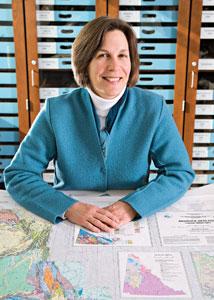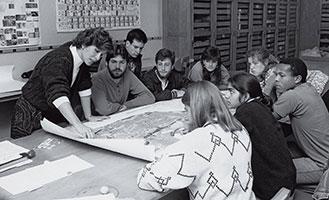Faculty Profile:Tekla Harms, Professor of Geology
Rock solid: Why Tekla Harms loves the Rockies, detests grading and pities Williams.
By Katherine Duke ’05

Tekla Harms received a Ph.D. from the University of Arizona before joining the Amherst faculty in 1987. She is now in her second term as chair of the geology department. She teaches the popular introductory course Geology 11, as well as upper-level courses in structural geology and in plate tectonics and continental dynamics. Her many research projects aim to help scientists better understand the evolution of mountain belts in the context of plate tectonics. In an interview with Amherst, Harms showed off the view of the Pelham hills and the Holyoke Range from her office in the new Earth Sciences Building and talked to us about the things she loves best: rocks, mountains and teaching.
ON DEVELOPING AN INTEREST IN GEOLOGY
Part of it was growing up in upstate New York and seeing all the glacial features. When I was 11, my family “saw the U.S.A. in our Chevrolet,” and coming from flat Rochester, N.Y., I remember thinking the Rocky Mountains were the best place on earth. So, as is very unusual for a geologist, I went to college intending to study geology. To this day, I research mountain belts. My focus has shifted from the scenery and the atmosphere—which I still love—to the intellectual endeavor: How did the earth build these structures? What are they like inside? How can we read those internal characteristics as a record of how they were built?

ON LIFE AS A YOUNG, FEMALE SCIENTIST
In the early days, I was often asked if my father was a geologist. People thought the most likely reason I would want to be a geologist was that I was emulating my father—that it wouldn’t be an independent idea that a girl would have. My father was not a geologist; not at all. This is an independent idea that a girl would have.
ON CHANGE IN HER DISCIPLINE
Consistent with major developments in earth sciences, over the past 10 years we have shifted from a rather traditional—what we would call “whole-earth”—geology department to one that also looks at the surface environment of the earth. Whole-earth dynamics are things like earthquakes, volcanoes, plates moving and the mantle convecting. Environmental dynamics are things like climate change, biogeochemistry and hydrogeology. I am still a solid-earth geologist, so I teach many of the same subjects that I taught when I first got here.
ON PAPERWORK
I hate grading, because all of the fun stuff is done by then. But it’s where students improve, so you need to pay attention to it and do it. I love geology; there’s nothing I’d rather think about or talk about, and there are plenty of aspects of my job, especially as department chair, that aren’t about geology—they’re about administration or other necessary endeavors. It’s during teaching that I get to share, with people who are interested, those things that most interest me. That is the fun part.
ON TAKING STUDENTS INTO THE FIELD
It’s fun to share with students that sense of discovery: Why is it this way? Let’s see what’s over that hill—maybe it will explain it. Students see with unfettered, uncluttered, unprejudiced eyes. Scientists fight all the time against their own concepts of the way things are and the way things should be. That can cloud your powers of observation; you’ll overlook things because you’re looking so hard for something else. Students who are inexperienced don’t know enough to be looking hard for the other thing, so they see it all with equal eyes. Very often they’ll see things that I would have overlooked.
ON FIELDWORK IN SOUTHWESTERN MONTANA
We’re looking at rocks that are 1.7 billion—that’s billion with a b—years old and older. The rocks appear to have stood on the edge of the North American continent and to have experienced a collision with something else, making a mountain belt with the deformation and metamorphism that goes along with mountain building. We want to figure out how that happened. The larger question concerns the early history of continents—how continents came to be, how they evolved over time and how they came to be like the continents that we understand today.
ON THE GEOLOGY OF THE AMHERST AREA
When people take Geology 11, they find that our area was first an inland sea, starting 500 million years ago, which is just one-eighth of geologic time. Shortly thereafter, it became involved in all the excitement of continental collision, complete with mountain-building, metamorphism and deformation. And not very long after that, 200 million years ago, it became involved in continental rifting, which is when the dinosaur footprints were formed. Many don’t know that what holds up the Holyoke Range is an immense lava flow that extruded during rifting; this place was just a lava pool, from Greenfield, Mass., to Hartford, Conn., at that time. Most recently, in the last 4 million years, the region has been covered up by four kilometers of glacial ice. This region has been an absolute hotbed of geologic activity through time.
ON WILLIAMS
Poor, poor, sad Williamstown is missing the rifting period and the big pools of lava and the dinosaur footprints. They’ve got the glacial stuff, they’ve got the mountain-building stuff, but it’s sad.
ON MAKING HER MARK
I have worked hard to find the evidence to explain the geologic history of parts of the Rocky Mountains. I have done more to obfuscate than to clarify: I have generally come out saying, “No, the problem is much bigger than we thought! Not only is there this, but there’s this, too, and we don’t understand that either!”
ON HOME
I live in the Pelham hills. I can see the area of my house from my office. I garden, badly. I’ve perfected the art of killing azaleas, and I’m moving on to rhododendrons. But it does get me in the out-of-doors and get my hands in the dirt. I have built many, many linear feet of stone walls around my yard. I really enjoy working with stone.
Duke is the Ives Washburn Fellow in the Office of Public Affairs.